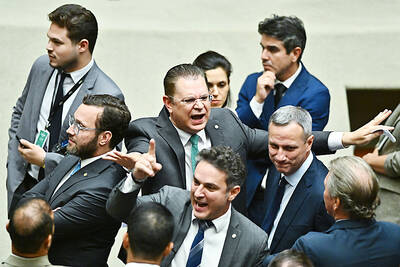Huge geysers on Saturn’s moon Enceladus may be fed by a salty sea below its surface, boosting the odds of extraterrestrial life in our own solar system, a study released yesterday showed.
Researchers in Europe detected salt particles in the volcanic vapor-and-ice jets that shoot hundreds of kilometers into space, the strongest evidence to date of a liquid ocean under the moon’s icy crust.
Scientists already knew that tiny Enceladus, only 500km across, had two of the three essential ingredients for the emergence of life.
One is an energy source, produced in this case by “tidal warming” driven by the shifting gravitational tug of its parent planet during the moon’s lopsided orbit, and perhaps by other forces too.
The Cassini spacecraft circling Saturn since 2004 has also found a potentially life-sustaining mix of organic chemicals in Enceladus’ plumes, ejected from a quartet of 120km long fractures — known as “tiger stripes” — aligned on the moon’s south pole.
That left the third critical ingredient: liquid water.
Since their discovery in 2005, the giant geysers have fueled intense speculation on the presence of a subterranean ocean, and the new discovery goes a long way toward resolving one of the most hotly debated topics in planetary science.
A team led by Frank Postberg of the University of Heidelberg studied data from Cassini’s Cosmic Dust Analyzer, and tested their findings in laboratory experiments.
Their results, published in the British journal Nature, show that ice grains in the Enceladus plumes contain substantial quantities of sodium salts and that the moon’s hidden sea — if there is one — could be as salty as Earth’s oceans.
“The abundance of various salt components in the particles ... exhibit a compelling similarity to the predicted composition of a subsurface Enceladus ocean in contact with its rock core,” the researchers said. “Individual plume sources stay active for years, implying outflow from a large reservoir.”
Sodium is a good telltale tracer of possible liquid water for two reasons, according to John Spencer of the Southwest Research Institute in Boulder, Colorado.
It is highly soluble, “so any Enceladan water that has prolonged contact with the moon’s silicate core should be rich is sodium salts, like Earth’s oceans,” he said in a commentary for Nature.
Sodium also scatters sunlight efficiently in the orange-yellow range of the spectrum, and is thus easy to detect even in minute quantities.
In a second study, also in Nature, a team led by Nicholas Schneider of Colorado University likewise looked for salts in Enceladus’ plumes, this time using spectrographs on Earth-bound telescopes.
That it failed to detect any would seem to challenge Postberg’s findings, but the Earth-based observations — combined with the Cassini data — may in fact give us additional clues as to how they may be true, Spencer said.
It tells us, for example, that the plumes could not have been formed by boiling salty water spewing directly out of Enceladus’ tiger stripes, otherwise the sodium would be so abundant as to be observable from Earth.
Instead, the plumes could come from salty water distilling into fresh water vapors, but not through evaporation as happens over Earth’s oceans, but rather in pressurized chambers under the moon’s surface.
Cassini is scheduled to make four additional up-close fly-bys of Enceladus before the middle of next year, and another dozen in the next five years if its mission is extended, so lingering doubts on the moon’s hidden seas may soon be put to rest.

A plan by Switzerland’s right-wing People’s Party to cap the population at 10 million has the backing of almost half the country, according to a poll before an expected vote next year. The party, which has long campaigned against immigration, argues that too-fast population growth is overwhelming housing, transport and public services. The level of support comes despite the government urging voters to reject it, warning that strict curbs would damage the economy and prosperity, as Swiss companies depend on foreign workers. The poll by newspaper group Tamedia/20 Minuten and released yesterday showed that 48 percent of the population plan to vote

PARLIAMENT CHAOS: Police forcibly removed Brazilian Deputy Glauber Braga after he called the legislation part of a ‘coup offensive’ and occupied the speaker’s chair Brazil’s lower house of Congress early yesterday approved a bill that could slash former Brazilian president Jair Bolsonaro’s prison sentence for plotting a coup, after efforts by a lawmaker to disrupt the proceedings sparked chaos in parliament. Bolsonaro has been serving a 27-year term since last month after his conviction for a scheme to stop Brazilian President Luiz Inacio Lula da Silva from taking office after the 2022 election. Lawmakers had been discussing a bill that would significantly reduce sentences for several crimes, including attempting a coup d’etat — opening up the prospect that Bolsonaro, 70, could have his sentence cut to

A powerful magnitude 7.6 earthquake shook Japan’s northeast region late on Monday, prompting tsunami warnings and orders for residents to evacuate. A tsunami as high as three metres (10 feet) could hit Japan’s northeastern coast after an earthquake with an estimated magnitude of 7.6 occurred offshore at 11:15 p.m. (1415 GMT), the Japan Meteorological Agency (JMA) said. Tsunami warnings were issued for the prefectures of Hokkaido, Aomori and Iwate, and a tsunami of 40cm had been observed at Aomori’s Mutsu Ogawara and Hokkaido’s Urakawa ports before midnight, JMA said. The epicentre of the quake was 80 km (50 miles) off the coast of

RELAXED: After talks on Ukraine and trade, the French president met with students while his wife visited pandas, after the pair parted ways with their Chinese counterparts French President Emmanuel Macron concluded his fourth state visit to China yesterday in Chengdu, striking a more relaxed note after tough discussions on Ukraine and trade with Chinese President Xi Jinping (習近平) a day earlier. Far from the imposing Great Hall of the People in Beijing where the two leaders held talks, Xi and China’s first lady, Peng Liyuan (彭麗媛), showed Macron and his wife Brigitte around the centuries-old Dujiangyan Dam, a World Heritage Site set against the mountainous landscape of Sichuan Province. Macron was told through an interpreter about the ancient irrigation system, which dates back to the third century